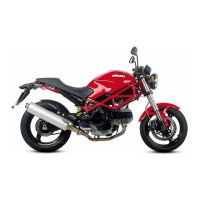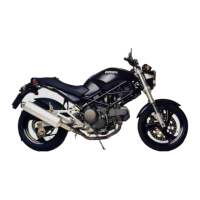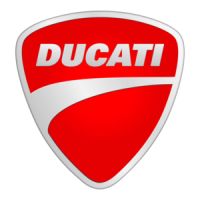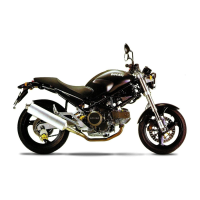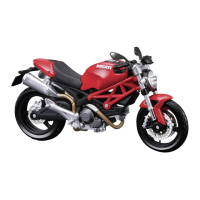
 Loading...
Loading...
Do you have a question about the Ducati MONSTER 696 and is the answer not in the manual?
| Displacement | 696 cc |
|---|---|
| Bore x Stroke | 88 x 57.2mm |
| Compression Ratio | 10.7:1 |
| Power | 80 hp (59 kW) @ 9000 rpm |
| Transmission | 6-speed |
| Frame | Tubular steel Trellis frame |
| Front Brake | 2 x 320 mm discs, 4-piston radial calipers |
| Rear Brake | 245 mm disc, 2-piston caliper |
| Seat Height | 770mm (30.3 in) |
| Engine Type | L-Twin, 2 valves per cylinder Desmodromic |
| Torque | 69 Nm (51 lb-ft) @ 7750 rpm |
| Fuel System | Electronic fuel injection, 45 mm throttle body |
| Exhaust | 2-1-2 system with catalytic converter and lambda probe |
| Front Suspension | 43 mm upside-down forks |
| Rear Suspension | Progressive with preload and rebound adjustable monoshock |
| Dry Weight | 161 kg (355 lb) |
| Fuel Capacity | 15 L (3.9 US gal) |
Explanation of warning symbols and safety messages used to alert users to potential hazards.
Stresses valid license, no alcohol/drugs, and doctor consultation for medications.
Emphasizes gear importance: helmet, gloves, jacket, and pants for safety.
Advises performing pre-ride checks and familiarizing with controls for safety.
Safe refuelling practices: engine off, no smoking, avoid spills, do not overfill.
Warns about fuel flammability, ethanol limits (E10), and contact precautions.
Emphasizes weight distribution, not exceeding max weight, and securing luggage properly.
Covers engine oil risks, brake lining debris, brake fluid, and coolant hazards.
Warns about battery explosive gases and requires charging in a well-ventilated area.
Details LCD, RPM, Neutral, Fuel, Turn, Oil Pressure lights.
Explains High Beam, Diagnosis, Rev Limiter lights.
Lists Speedometer, Odometer, Trip Meter, Trip Fuel, Clock, Air Temp, Lap Timer, RPM, Lap Time.
Shows total distance, saves permanently, resets to 99999 if limit exceeded.
Displays speed value (with 8% increase) and behavior over 299 km/h.
Shows distance since last reset; reset procedure via button.
Shows distance traveled on fuel reserve; activates on low fuel.
Indicates due service; can only be reset by a dealer.
Menu procedure to disable ABS; notes indicator light behavior.
Auto-diagnostics after key-off, viewing malfunctions and error codes.
Electronic system inhibiting engine operation without recognized key signal.
Code recognition for engine start, troubleshooting start issues.
Describes two black keys for starting, opening locks, and their ID plate.
Using the code card to start the engine if the key fails.
Step-by-step process for entering the electronic code from the Code Card.
Up to 1000 km: RPM limits, break-in for engine, brakes, suspensions.
1000-2500 km: RPM limits, strict adherence to rules.
Checks: fuel, oil, brakes, tires, controls, lights, locks, stand.
Checks phonic wheels; warns about mud and wheelies affecting ABS.
Procedure, warnings, oil light behavior.
Using choke, battery impact on starter motor.
Guidance for high and cold ambient temperatures, choke use.
Clutch, gear, and throttle use for smooth movement.
Upshifting, downshifting, and uphill riding techniques.
General braking, ABS mechanics, pressure limiting.
Warnings for ABS off, adverse conditions, and general braking precautions.
Reducing speed, shifting gears, and turning the ignition key off.
No overfilling, octane rating, ethanol limits.
Checks oil via sight glass on clutch cover with cold engine.
Tasks: engine oil, filters, valve clearances, timing belts.
Tasks: tyres, brakes, bearings, chain, clutch, wheels.
Tasks: fork, shocks, sprockets, lubrication, battery, road test.
Warns against fuel additives and reiterates ethanol content limits.
Details cylinder configuration, bore, stroke, and displacement.
Lists power, torque, and Desmodromic timing system details.
Details front brake discs, calipers, pump, and rear brake disc, caliper.
Lists gearbox ratios and drive chain size.
Identifies fuses, ratings, and locations in the fusebox.
Provides diagrams of the fusebox and ABS fuses.
Explains how to identify blown fuses and replacement warnings.
